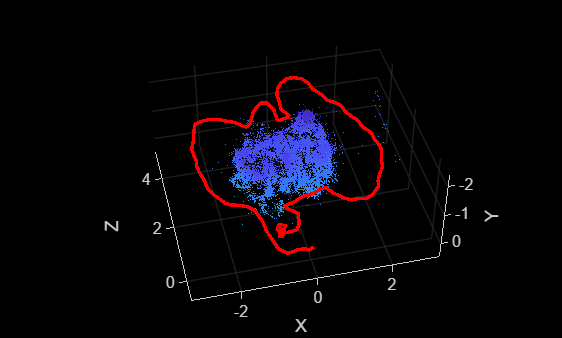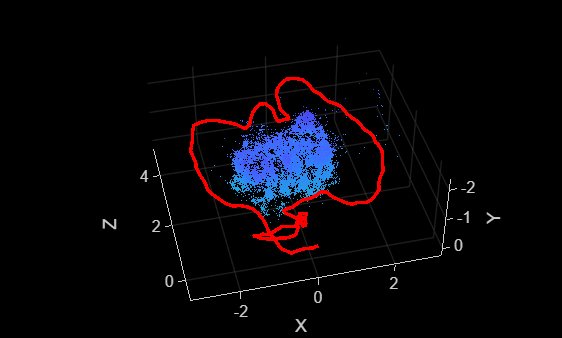checkStatus
Description
Examples
Perform RGB-D visual simultaneous localization and mapping (vSLAM) using the data from the TUM RGB-D Benchmark. You can download the data to a temporary directory using a web browser or by running this code:
baseDownloadURL = "https://vision.in.tum.de/rgbd/dataset/freiburg3/rgbd_dataset_freiburg3_long_office_household.tgz"; dataFolder = fullfile(tempdir,"tum_rgbd_dataset",filesep); options = weboptions(Timeout=Inf); tgzFileName = dataFolder+"fr3_office.tgz"; folderExists = exist(dataFolder,"dir"); % Create a folder in a temporary directory to save the downloaded file if ~folderExists mkdir(dataFolder) disp("Downloading fr3_office.tgz (1.38 GB). This download can take a few minutes.") websave(tgzFileName,baseDownloadURL,options); % Extract contents of the downloaded file disp("Extracting fr3_office.tgz (1.38 GB) ...") untar(tgzFileName,dataFolder); end
Create two imageDatastore objects. One to store the color images and the other to store the depth images.
colorImageFolder = dataFolder+"rgbd_dataset_freiburg3_long_office_household/rgb/"; depthImageFolder = dataFolder+"rgbd_dataset_freiburg3_long_office_household/depth/"; imdsColor = imageDatastore(colorImageFolder); imdsDepth = imageDatastore(depthImageFolder);
Select the synchronized pair of color and depth images.
data = load("rgbDepthPairs.mat");
imdsColor=subset(imdsColor, data.indexPairs(:, 1));
imdsDepth=subset(imdsDepth, data.indexPairs(:, 2));Specify your camera intrinsic parameters, and use them to create an RGB-D visual SLAM object.
intrinsics = cameraIntrinsics([535.4 539.2],[320.1 247.6],[480 640]); depthScaleFactor = 5000; vslam = rgbdvslam(intrinsics,depthScaleFactor);
Process each pair of color and depth images, and visualize the camera poses and 3-D map points.
for i = 1:numel(imdsColor.Files) colorImage = readimage(imdsColor,i); depthImage = readimage(imdsDepth,i); addFrame(vslam,colorImage,depthImage); if hasNewKeyFrame(vslam) % Query 3-D map points and camera poses xyzPoints = mapPoints(vslam); [camPoses,viewIds] = poses(vslam); % Display 3-D map points and camera trajectory plot(vslam); end % Get current status of system status = checkStatus(vslam); % Stop adding frames when tracking is lost if status == uint8(0) break end end

Once all the frames have been processed, reset the system.
while ~isDone(vslam) plot(vslam); end

reset(vslam);
Input Arguments
RGB-D visual SLAM object, specified as an rgbdvslam object.
Output Arguments
Current status of the RGB-D visual SLAM object, returned as a
TrackingLost, TrackingSuccessful, or
FrequentKeyFrames enumeration. This table describes these
enumerations.
| Enumeration Value | Numeric Value | Description |
|---|---|---|
TrackingLost | uint8(0) | Tracking is lost. The number of tracked feature points in the frame
currently being processed is less than the lower limit of the
If the
object does not accept enough frames as key frames, to improve tracking, you
can increase the upperLimit value of the
|
TrackingSuccessful | uint8(1) | Tracking is successful. The number of tracked feature points in the
frame currently being processed is between the lower limit and upper limit
values of the |
FrequentKeyFrames | uint8(2) | Tracking adds key frames too frequently. The number of tracked
feature points in the frame currently being processed is greater than the
upper limit of the |
Version History
Introduced in R2024a
MATLAB Command
You clicked a link that corresponds to this MATLAB command:
Run the command by entering it in the MATLAB Command Window. Web browsers do not support MATLAB commands.
Seleziona un sito web
Seleziona un sito web per visualizzare contenuto tradotto dove disponibile e vedere eventi e offerte locali. In base alla tua area geografica, ti consigliamo di selezionare: .
Puoi anche selezionare un sito web dal seguente elenco:
Come ottenere le migliori prestazioni del sito
Per ottenere le migliori prestazioni del sito, seleziona il sito cinese (in cinese o in inglese). I siti MathWorks per gli altri paesi non sono ottimizzati per essere visitati dalla tua area geografica.
Americhe
- América Latina (Español)
- Canada (English)
- United States (English)
Europa
- Belgium (English)
- Denmark (English)
- Deutschland (Deutsch)
- España (Español)
- Finland (English)
- France (Français)
- Ireland (English)
- Italia (Italiano)
- Luxembourg (English)
- Netherlands (English)
- Norway (English)
- Österreich (Deutsch)
- Portugal (English)
- Sweden (English)
- Switzerland
- United Kingdom (English)